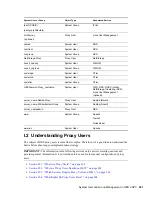
System User and Group Management in OES 2 SP3
275
Table I-6
Options for Limiting the Number of Proxy Users
Approach
Security Considerations
Manageability Considerations
Per Service per
Server (default)
For CIFS, iFolder 3, NSS,
and Samba this is the most
secure option. Passwords
for these are system-
generated and not known by
anyone.
For LUM there is no option
to have a system-generated
password.
For DNS, DHCP, and
NetStorage, the install
admin’s credentials are used
by default. This has separate
security implications as
outlined in
“Avoid Assigning
an Admin User As a Proxy
User” on page 274
.
This approach requires no proxy user planning.
Services are installed at the same time as the OES
server.
This is a good option for small organizations or
installations where only a few services are used.
This is not a good option if security policies dictate that
all passwords must be reset periodically.
Per Server
This confines any security
vulnerabilities to individual
servers and is the scenario
for which the Common Proxy
User was developed.
This requires that a proxy user for the server is created
before the server is installed.
If the Common Proxy User is not leveraged, then for the
first server in the tree, eDirectory and iManager must be
installed with the server. After the server installation
finishes, a proxy user can be created. And finally the
services can be installed and configured to use the
proxy user for the server.
This approach is useful when each OES server is
managed by a separate administrator, or for enterprises
where branch users access a server in the branch
office.
Knowing the proxy user password is not required unless
additional services will be installed or password policies
require periodic changing, in which cases the install
admin must know the proxy user’s password.
Per Partition
This confines any security
vulnerabilities to individual
partitions.
This is useful when users are co-located with the OES
servers in a single partition, and cross-partition access
of users to services is rare.
This is a good approach for organizations where
eDirectory administration is done at a partition level.
This requires that a proxy user for the first server in the
partition is created before services are installed in the
partition.
The install admin must know the proxy user’s password.
Summary of Contents for OPEN ENTERPRISE SERVER - CONVERSION GUIDE 12-2010
Page 12: ...12 OES 2 SP3 Planning and Implementation Guide...
Page 24: ...24 OES 2 SP3 Planning and Implementation Guide...
Page 50: ...50 OES 2 SP3 Planning and Implementation Guide...
Page 74: ...74 OES 2 SP3 Planning and Implementation Guide...
Page 78: ...78 OES 2 SP3 Planning and Implementation Guide...
Page 80: ...80 OES 2 SP3 Planning and Implementation Guide...
Page 96: ...96 OES 2 SP3 Planning and Implementation Guide...
Page 146: ...146 OES 2 SP3 Planning and Implementation Guide...
Page 176: ...176 OES 2 SP3 Planning and Implementation Guide...
Page 210: ...210 OES 2 SP3 Planning and Implementation Guide...
Page 218: ...218 OES 2 SP3 Planning and Implementation Guide...
Page 226: ...226 OES 2 SP3 Planning and Implementation Guide...
Page 234: ...234 OES 2 SP3 Planning and Implementation Guide...
Page 236: ...236 OES 2 SP3 Planning and Implementation Guide...
Page 244: ...244 OES 2 SP3 Planning and Implementation Guide...
Page 246: ...246 OES 2 SP3 Planning and Implementation Guide...
Page 250: ...250 OES 2 SP3 Planning and Implementation Guide...
Page 254: ...254 OES 2 SP3 Planning and Implementation Guide...
Page 258: ...258 OES 2 SP3 Planning and Implementation Guide...
Page 284: ...284 OES 2 SP3 Planning and Implementation Guide...
Page 286: ...286 OES 2 SP3 Planning and Implementation Guide...
Page 294: ...294 OES 2 SP3 Planning and Implementation Guide...
















































